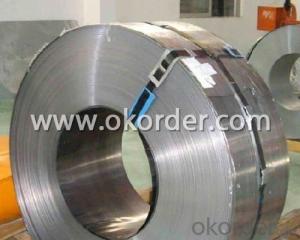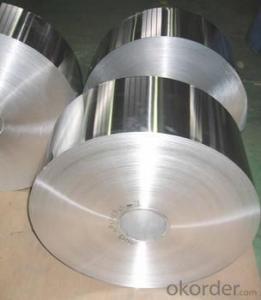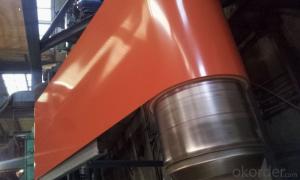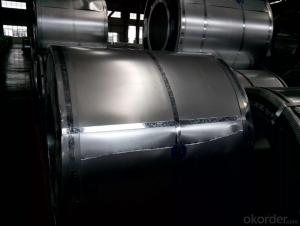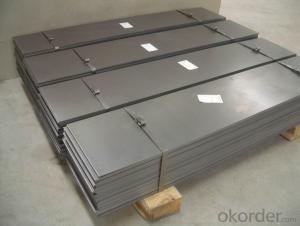Hot Rolled/Cold Rolled Steel Strip Band Steel Made In China
- Loading Port:
- Tianjin
- Payment Terms:
- TT OR LC
- Min Order Qty:
- 100 m.t.
- Supply Capability:
- 30000 m.t./month
OKorder Service Pledge
OKorder Financial Service
You Might Also Like
Item specifice
Product Description:
OKorder is offering Hot Rolled/Cold Rolled Steel Strip Band Steel Made In China at great prices with worldwide shipping. Our supplier is a world-class manufacturer of steel, with our products utilized the world over. OKorder annually supplies products to European, North American and Asian markets. We provide quotations within 24 hours of receiving an inquiry and guarantee competitive prices.
Product Applications:
Hot Rolled/Cold Rolled Steel Strip Band Steel Made In China are ideal for structural applications and are widely used in the construction of buildings and bridges, and the manufacturing, petrochemical, and transportation industries.
Product Advantages:
OKorder's Hot Rolled/Cold Rolled Steel Strip Band Steel Made In China are durable, strong, and resist corrosion.
Main Product Features:
· Premium quality
· Prompt delivery & seaworthy packing (30 days after receiving deposit)
· Corrosion resistance
· Can be recycled and reused
· Mill test certification
· Professional Service
· Competitive pricing
Product Specifications:
Spring steel is divided into two types, one is alloy spring steel, and other one is carbon spring steel.
Alloy spring steel is a type that is used for manufacturing springs and other elastic parts. Spring steel should have high elastic limit and ratio of yield strength and tensile strength to make sure that the springs obtain enough power of elastic deformation and can bear much load.
Types of alloy spring steel: Si-Mn spring steel, Si-Cr spring steel, Cr-Mn Spring steel, Cr-V spring steel and so on.
Specification of Spring Steel Strip
-Material: 50CrVA
-Standard: GB/T 1222-2007
-Type: Spring Steel
Chemical Composition:
C | Si | Mn | S |
0.26~0.34 | 0.17~0.37 | ≤0.40 | ≤0.030 |
P | Cr | Ni | Cu |
≤0.030 | 2.00~2.50 | ≤0.35 | ≤0.25 |
V | W | ||
0.50~0.80 | 4.00~4.50 |
Mechanical Properties:
-Yield Strength σs (MPa): ≥1470 (150)
-Elongation δ10(%):≥7
-Hardness:
1, Hot rolled + Heat treatment, ≤321HB
2, Cold drawn + Heat treatment: ≤321HB
-Impact Power: ≥40
Norm of heat treatment:
1, Quenching: 1050℃~1100℃.
2, Cooled by oil.
3, Tempering: 600℃±50℃.
Usage/Applications of Spring Strip Steel:
-Due to the elements W, Cr and V, this type of spring steel obtain pretty high hardenability and nice mechanical properties under room temperature and high temperature. The tempering stability and hot workability are good.
-Being used under the state of quenching and high temperature tempering. It’s usually used as heat-resisting springs with working temperature below 500℃, like main secure valve spring of furnace and turbine steam seal leaf springs.
FAQ:
Q1: Why buy Materials & Equipment from OKorder.com?
A1: All products offered byOKorder.com are carefully selected from China's most reliable manufacturing enterprises. Through its ISO certifications, OKorder.com adheres to the highest standards and a commitment to supply chain safety and customer satisfaction.
Q2: How do we guarantee the quality of our products?
A2: We have established an advanced quality management system which conducts strict quality tests at every step, from raw materials to the final product. At the same time, we provide extensive follow-up service assurances as required.
Q3: How soon can we receive the product after purchase?
A3: Within three days of placing an order, we will begin production. The specific shipping date is dependent upon international and government factors, but is typically 7 to 10 workdays.
Q4: What makes stainless steel stainless?
A4: Stainless steel must contain at least 10.5 % chromium. It is this element that reacts with the oxygen in the air to form a complex chrome-oxide surface layer that is invisible but strong enough to prevent further oxygen from "staining" (rusting) the surface. Higher levels of chromium and the addition of other alloying elements such as nickel and molybdenum enhance this surface layer and improve the corrosion resistance of the stainless material.
Q5: Can stainless steel rust?
A5: Stainless does not "rust" as you think of regular steel rusting with a red oxide on the surface that flakes off. If you see red rust it is probably due to some iron particles that have contaminated the surface of the stainless steel and it is these iron particles that are rusting. Look at the source of the rusting and see if you can remove it from the surface.
Images:
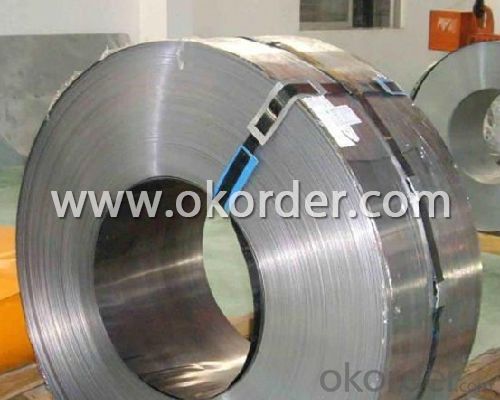

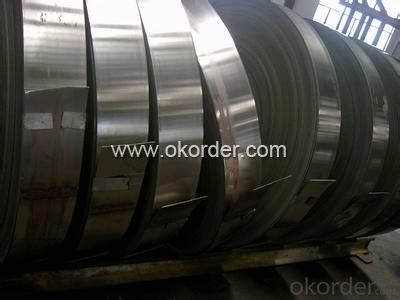
- Q:What are the current trends in steel strip manufacturing?
- Some current trends in steel strip manufacturing include the increasing use of automation and advanced technologies to improve efficiency and productivity, the development of high-strength and lightweight steel strips for various industrial applications, and the focus on sustainability by reducing energy consumption and waste generation during the manufacturing process. Additionally, there is a growing demand for customized steel strips to meet specific requirements of different industries, such as automotive, construction, and packaging.
- Q:How are steel strips used in the furniture industry?
- Steel strips are commonly used in the furniture industry for various purposes, such as reinforcing furniture frames, providing structural support, and enhancing the overall durability and stability of furniture pieces. These strips can be found in different types of furniture, including chairs, tables, and cabinets, helping to ensure their longevity and strength.
- Q:Are steel strips suitable for the manufacturing of cookware?
- Yes, steel strips are suitable for the manufacturing of cookware. Steel is a durable and versatile material that offers excellent heat conductivity and even distribution. It can withstand high temperatures and is resistant to rust and corrosion, making it ideal for cooking purposes. Additionally, steel strips can be easily shaped and molded into various cookware designs, allowing for the creation of different types and sizes of pots, pans, and other kitchen utensils.
- Q:How are steel strips cold rolled?
- Cold rolling is a process wherein steel strips are passed through a series of rollers at room temperature to decrease their thickness and enhance their surface finish. The initial stage involves cleaning the steel strip to eliminate any impurities or surface contaminants. Once cleaned, the strip is fed into rolling mills, comprised of rollers that gradually reduce its thickness. During the cold rolling process, the rollers work in pairs, consisting of a work roll and a backup roll. The work roll applies pressure to the strip, while the backup roll provides support and maintains the desired shape. These rolls are typically constructed from high-quality steel or other durable materials capable of withstanding the forces and pressures involved. As the strip progresses through the rolling mills, it experiences successive reductions in thickness. The distance between the rollers diminishes gradually, resulting in compression and elongation of the strip. This reduction in thickness enhances the mechanical properties of the steel, including its strength and hardness. Furthermore, the cold rolling process enhances the surface finish of the steel strip. The pressure applied by the rollers smooths out any surface imperfections and defects, yielding a more uniform and sleeker surface. To ensure precision and consistency, the cold rolling process employs various control systems and measurements. These include gauges and sensors that monitor the dimensions, temperature, and other parameters of the strip as it passes through the rolling mills. In summary, cold rolling is a crucial step in steel strip production. It refines the steel's properties, such as thickness, strength, and surface finish, making it suitable for a diverse range of applications in industries such as automotive, construction, and manufacturing.
- Q:Can steel strips be used in the aerospace industry?
- Yes, steel strips can be used in the aerospace industry. They are commonly used for various applications such as structural components, fasteners, and support brackets. Steel strips offer high strength, durability, and heat resistance, making them suitable for aerospace manufacturing and maintenance.
- Q:How do steel strips perform in terms of electrical conductivity?
- Steel strips have relatively low electrical conductivity compared to other metals such as copper or aluminum.
- Q:How are steel strips processed for perforating?
- Steel strips are processed for perforating by passing them through a specialized machine that uses a combination of pressure and sharp tools to create evenly spaced holes or perforations on the surface of the strip. This process allows for the customization of the strip's design and enables it to be used in various applications such as filtration, ventilation, or decorative purposes.
- Q:What is the machinability of a steel strip?
- The machinability of a steel strip refers to its ease of being cut, drilled, or shaped using various machining processes such as milling, turning, or grinding. It is a critical property that determines the efficiency and effectiveness of these manufacturing processes. The machinability of a steel strip depends on several factors, including the alloy composition, microstructure, hardness, and surface finish. Certain elements and impurities in the steel, such as sulfur, phosphorus, and lead, can enhance or hinder its machinability. A steel strip with high machinability will exhibit excellent chip formation, reduced cutting forces, and longer tool life. It will allow for higher cutting speeds and feeds, resulting in faster production rates and improved productivity. Additionally, a highly machinable steel strip will generate minimal heat and produce less wear on cutting tools, thus reducing costs associated with tooling and maintenance. On the other hand, a steel strip with poor machinability will pose challenges during machining operations. It may exhibit excessive tool wear, increased cutting forces, and poor chip formation. This can lead to slower cutting speeds, reduced productivity, and higher costs due to frequent tool changes and maintenance. To enhance the machinability of a steel strip, various techniques can be employed, such as alloying with elements that promote machinability, heat treatments to modify the microstructure, and surface treatments to improve surface finish and lubricity. These methods aim to optimize the steel's properties and make it more suitable for specific machining applications. In summary, the machinability of a steel strip is a crucial characteristic that affects the ease, efficiency, and cost-effectiveness of machining processes. It is influenced by factors like alloy composition, microstructure, hardness, and surface finish, and can be enhanced through various techniques and treatments.
- Q:How are steel strips processed for surface leveling?
- Surface leveling of steel strips can be achieved through various methods. One commonly used technique is roller leveling, where the steel strip is fed through a set of high-pressure rollers. These rollers exert force on the strip, gradually bending it in the opposite direction of surface irregularities, effectively leveling the surface. Roller leveling can be performed as a standalone process or integrated into a continuous processing line, such as a rolling mill. Another method employed for surface leveling is tension leveling. Here, the steel strip undergoes tension forces as it passes through a series of bridle rolls positioned at different angles. These rolls stretch and elongate the strip, reducing surface irregularities and enhancing flatness. Tension leveling is particularly effective in eliminating defects like crossbow and center buckle in the steel strip. Moreover, some steel strips may undergo temper rolling, a process in which the strip is heated and rapidly cooled. This alters the metallurgical structure of the steel, improving its flatness. Temper rolling also enhances the mechanical properties of the strip, including hardness and strength. It is important to note that the specific surface leveling process employed may vary depending on the requirements of the steel strip and desired end product. Different combinations of roller leveling, tension leveling, and temper rolling can be utilized to achieve the desired surface quality, flatness, and dimensional accuracy of the steel strip.
- Q:What are the common painting techniques for steel strips?
- Steel strips can be painted using various techniques. The most widely employed technique is spray painting, which involves using a spray gun to evenly distribute paint onto the strip's surface. This method is highly effective and yields a smooth and uniform finish. Another commonly used technique is brush painting, where paint is manually applied to the strip using a paintbrush. Brush painting is ideal for smaller areas or intricate designs that demand precision. Electrostatic painting is a popular method for painting steel strips. It entails applying an electrostatic charge to the paint particles, which are then attracted to the grounded strip. This technique ensures a highly consistent and long-lasting finish. Powder coating is also frequently used for steel strips. This method involves applying a dry powdered paint to the strip, which is then melted and forms a durable coating when heated. Powder coating is renowned for its exceptional resistance to chipping, scratching, and fading. Lastly, immersion painting is a technique where the strip is submerged in a paint tank. This is often employed for large-scale projects that require efficiency. The strip is fully coated in paint and then removed from the tank to dry. In conclusion, the choice of painting technique for steel strips depends on factors such as project size, desired finish, and efficiency requirements. Each technique offers its own advantages and can produce high-quality results when applied appropriately.
1. Manufacturer Overview |
|
|---|---|
| Location | |
| Year Established | |
| Annual Output Value | |
| Main Markets | |
| Company Certifications | |
2. Manufacturer Certificates |
|
|---|---|
| a) Certification Name | |
| Range | |
| Reference | |
| Validity Period | |
3. Manufacturer Capability |
|
|---|---|
| a)Trade Capacity | |
| Nearest Port | |
| Export Percentage | |
| No.of Employees in Trade Department | |
| Language Spoken: | |
| b)Factory Information | |
| Factory Size: | |
| No. of Production Lines | |
| Contract Manufacturing | |
| Product Price Range | |
Send your message to us
Hot Rolled/Cold Rolled Steel Strip Band Steel Made In China
- Loading Port:
- Tianjin
- Payment Terms:
- TT OR LC
- Min Order Qty:
- 100 m.t.
- Supply Capability:
- 30000 m.t./month
OKorder Service Pledge
OKorder Financial Service
Similar products
New products
Hot products
Related keywords
